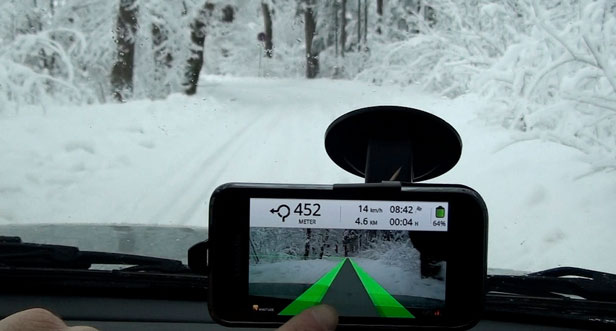GPS App Keeps Drivers’ Eyes on the Road

Many drivers use GPS to find their way, but shifting their attention to the maps on the device can distract them from actual driving. A new app, Wikitude Drive, aims to help drivers navigate without diverting their attention away from the road. Philipp Breuss-Schneeweis, founder of Wikitude GmbH, the Austrian company that developed the app, claims that “seeing the cars in front of you in the camera image can help you to avoid a crash. Many accidents actually happen when drivers look at the navigation system and the car ahead stops.”
Wikitude Drive works by using an Android tablet or smart phone’s camera to capture the roadway in front of the driver. The app then pulls information from a wide variety of sites, including Wikipedia, Yelp, Last.fm, Foursquare, and other online databases, to collect points of interest for the user, such as local businesses and concert locations. It uses the GPS and digital compass built into many phones and tablets to mark these sites directly on a live feed displayed on the device’s screen—a technique known as augmented reality.
Wikitude Drive has only been officially supported on a handful of phones, but in practice it works on most Android devices.
Breuss-Schneeweis says that he’s long wanted to use augmented reality for navigation. “The idea was to draw the driving instructions directly onto reality rather than an abstract map,” he says. The company began developing the app in 2009, and released it in Europe in December of last year. Along the way, Breuss-Schneeweis says, the developers had to ensure that the app used GPS sensors accurately, matching driving directions to streets exactly. They also had to make the app work consistently despite a flurry of changes to the Android operating system and the wide variety of devices that use it.
Wikitude Drive’s developers hope this approach will keep users more focused on the road. As pointed out on the Wikitude Drive site, when a driver takes his or her eyes off the road for one second to look at a map screen when driving at 100 kilometers (60 miles) per hour, “the driver is actually ‘blind’ for 28 meters (92 feet).”
However, Paul Green, a research professor at University of Michigan’s Transportation Research Institute, is skeptical as to whether the app is addressing the biggest safety concerns. Drivers are most distracted by GPS devices and apps, he says, when they’re programming a destination. Green believes the best way to improve GPS driving safety would be to “lock out destination entry while the [navigational] system is in use.”
Green does say that the app could help solve very specific driving concerns, such as confusion while performing complex navigation maneuvers, or navigating through turns in an area with many roadways.
Keep Reading
Most Popular
Large language models can do jaw-dropping things. But nobody knows exactly why.
And that's a problem. Figuring it out is one of the biggest scientific puzzles of our time and a crucial step towards controlling more powerful future models.
How scientists traced a mysterious covid case back to six toilets
When wastewater surveillance turns into a hunt for a single infected individual, the ethics get tricky.
The problem with plug-in hybrids? Their drivers.
Plug-in hybrids are often sold as a transition to EVs, but new data from Europe shows we’re still underestimating the emissions they produce.
Stay connected
Get the latest updates from
MIT Technology Review
Discover special offers, top stories, upcoming events, and more.